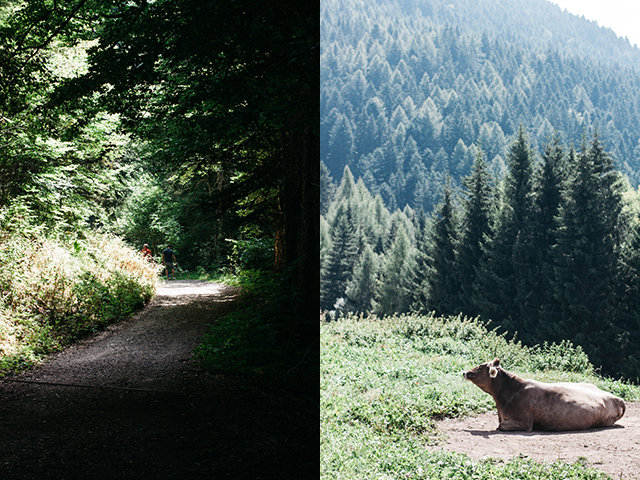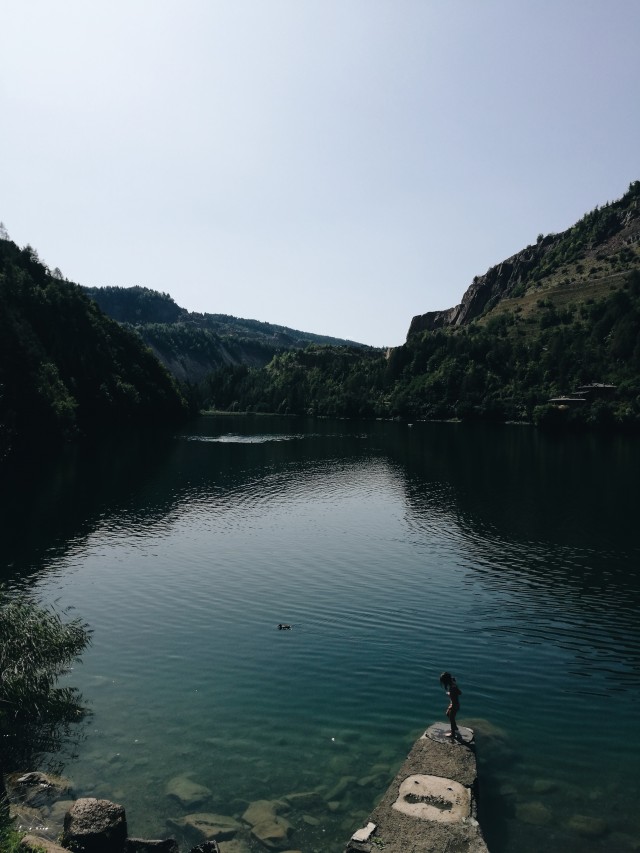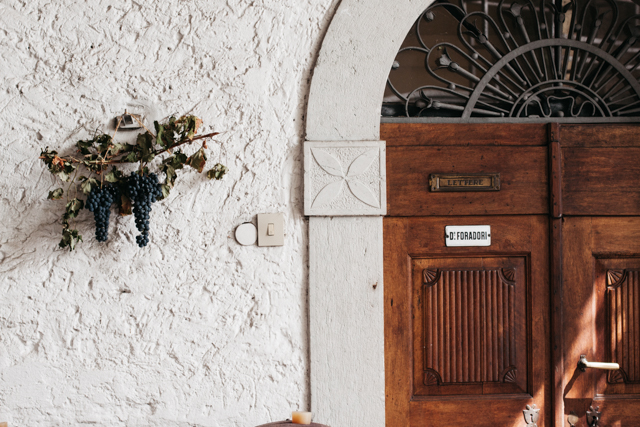
Last month we spent a few wonderful days visiting our friends Rosa and Massimo who live just outside of Trento. It was our third visit to the area (on one of them I snapped up this recipe for persimmon cake), so I feel it’s about time to share some our favourite things that we’ve been shown by locals.
Trento is only a four hour drive from Florence — passing Bologna and Verona on the way, which could make very good pit stops if you feel the need to, FYI — yet it feels a world away in terms of the landscape and the food, from the golden, rolling hills of Tuscany. Cue towering mountains harbouring mushrooms and berries, lush valleys and turquoise lakes, vines grown on pergolas, enormous plates of sauerkraut and polenta in abundant portions, delicious wines and rustic cakes with German names.


Trento is the capital of Trentino, an unusual region of Italy because its official languages are Italian and German and it is actually made up of two self-governing provinces and is known as Trentino-Alto Adige or Trentino-Sudtirol. Confused? Since the eighth century, it has been part of the Austro-Hungarian Empire and only a century ago did it become Italian. It is squeezed between Lombardy and the Veneto to the west and southeast and to the north lies Austria and Switzerland. So it is no surprise that many of the food influences come from its neighbours — particularly the northern ones.
Eating in the region means eating heartily, even in the summer sunshine, we enjoyed abundant portions of canederli (large rustic dumplings made of bread, herbs and meat, ham or cheese in broth), masses of soft, creamy polenta with thinly sliced roast pork or sausage ragu and slow-cooked beans or thick venison steaks, sauerkraut and gnocchi (sometimes made of out of polenta). I think one waiter was highly disappointed that we weren’t able to finish our gargantuan plates one hot day on a mountain with a view of the Dolomites. Somehow there was always room for dessert, though — adopted from German and Austrian specialties, you can find cakes like black forest, schwarzplententorte (buckwheat cake, the recipe is below), sachertorte and linzertorte, often lathered with homemade, forest-picked berry jam and whipped cream.







A highlight visiting in late August was seeing the beginning of mushroom season in the form of market stalls in the pretty, pastel-tinted town of Trento, exploding with beautiful, local forest finds, from yolk-yellow chantarelles to large, fragrant porcini mushrooms. On the day of our arrival, our friends hosting us had been up at 5am to go porcini-gathering themselves so we were treated to a special dinner of fresh, woodsy porcini-coated pasta — and took home a kilo of irresistible chantarelles from the market.
This is one Italian region where you could say the wine might outshine the food and it’s worth spending the time visiting a few wineries. The ones in the guide below that we love are not only picturesque but well-equipped for visits with lovely tasting rooms.









Trento Mini Guide
Eat
Casa del Vino della Vallagarina — A wonderful place where you can drop in for a glass of wine, buy bottles to take home, dine at the restaurant or even sleep. Their enoteca is stocked with wine and other specialties from the region and the dining room (or terrace in the warm weather) offers an elegant, appealing menu.
Fichtenhof — This trattoria that sits atop Mount Corno with a stunning view over the valley below is a good starting point for a walk through the woods to work up the hearty appetite you’ll need for a meal of traditional delights here — think polenta with roast pork, gnocchi with lemon and wild herbs, apple strudel. Their kitchen garden (not to mention their backyard mountain forest) adds to the menu.
Gelateria Zenzero — Delicious, ‘natural’ gelato in the cute town of Borgo Sacco, not far from Rovereto, where you can sit riverside or wander the cobblestone streets. It also functions as a bistro but you may want to make a meal out of the gelato when you taste how good the daily offerings are (and when you see the giant “coppe” covered with fresh fruit coming out for people who know what to order.)
Drink
Dornach — A winery with a view run by biologist Karoline and her husband Patrick Uccelli, they produce extremely clean biodynamic, natural wines in the province of Bolzano. Their pinot bianco, pinot noir and an interesting macerated Gerwütztraminer that they simply call “G.” They also have a beautiful holiday apartment on the grounds that they rent out.
Eugenio Rosi — Eugenio and his wife, Tamara, specialise in Marzemino, one of the region’s native grapes, which they partially let dry on racks before pressing (an unusual step in the process). They use biodynamic principles even if they aren’t interested in gaining the certification for it. Don’t miss their cantina in a fourteenth century palazzo in the village of Calliano (Palazzo De Martin, Via III Novembre, Calliano), a very atmospheric place for a wine tasting.
Foradori — Elisabetta Foradori is a legend in the world of biodynamic wines. Her beautiful winery and wine tasting room is in the town Mezzalombardo, against a mountain backdrop, in the heart of teroldego country. She places great emphasis on biodiversity in the vineyard (which is interspersed with a beautiful vegetable garden, wild strawberries, fruit trees and a chicken coop) and is working on some very interesting wines fermented in terracotta amphora. In fact, her teroldago is something special to make your heart sing.
Visit
Lake Lases — A pretty alpine lake with clear blue waters, it’s a quiet place for a refreshing swim. It’s a great spot for kids because of its shallow edges (it does get to a depth of 25 meters though!) and shady trees, and older kids will like the rope for jumping into the deeper part of the lake.
Trento Markets — Trento is such a pretty, cobblestoned, pastel-hued city. The daily markets are in Piazza Vittoria and Piazza Erbe from 7am-1pm Monday to Saturday (on Saturdays it’s in Piazza Dante and Wednesdays in Piazza Filzi). Look out for seasonal specialties (in late summer that was wild blueberries and mushrooms) and the cheese stall selling the most delicious asiago cheese I’ve tasted.
Rovereto — A beautiful town dominated by a castle, a must visit here in Rovereto is MART, the Museum of Contemporary Art.

Torta di Granosaraceno
Buckwheat and jam cake
Known as schwarzplententorte in German or torta di granosaraceno in Italian, this is a very traditional recipe that reflects all of these aspects. It’s a simple, gluten-free cake, made wonderfully moist and dense with buckwheat, almond meal and grated apple (apples have a DOP — Protected Designation of Origin — status here in Trentino), then filled with tart lingonberry jam and topped with a veil of powdered sugar. It’s usually eaten for breakfast together with a big mug of caffe latte — or as a morning or afternoon snack.
The basic version of this recipe is without the apple (it can easily be eliminated from the recipe without changing the other proportions), while the oldest versions of this recipe call only for buckwheat flour, with almond meal (usually made by grinding whole almonds, skin on for colour) being a modern addition that adds to the dense crumb of this cake. Obligatory is the jam filling — you would normally find lingonberry jam (also known as mountain cranberries) used for this, we also saw local mountain blueberry jam. You could substitute cranberry or redcurrant jelly too, but if you do want to seek it out, try Ikea (lingonberry jam is also a national staple of Sweden!).
Serves 8
250 grams butter at room temperature
250 grams sugar
6 eggs, separated
250 grams buckwheat flour
250 grams almonds, skins on if possible, pulverised into almond meal
1 apple, peeled and grated
1 vanilla pod
200 gr of lingonberry jam (or similar)
1 heaped teaspoon of powdered sugar
Cream together the butter and sugar. Add the egg yolks and beat until pale and creamy. Add the buckwheat, almond meal, grated apple and the scraped seeds of the vanilla pod until just combined.
Beat the egg whites to stiff peaks. Gently fold in, bit by bit, into the batter until well combined and pour batter into a greased and lined round baking tin.
Bake at 180ºC/350ºF for about 50 minutes or until the cake is deep golden brown on top and a skewer inserted in the middle of the cake comes out clean. When cool enough to handle, remove cake from tin and slice in half lengthways. Spread the bottom layer with the lingonberry jam and replace the top layer. Just before serving, dust with powdered sugar.





Comments
Is this an Italian cake? What was used instead of lingonberries in the traditional cake. Love your recipies…
It is, but it’s complicated 🙂 Trentino-Alto Adige, though Italian, has (especially in the dessert department) many German and Austrian influences. Lingonberry is the traditional jam to use in this cake (but we also saw it made with homemade wild berries from the nearby woods)!
Oh Emiko! What a beautiful part of the world to spend some time in. And so interesting with the combination of Italian/German elements. x
It’s always so incredible to me that a four hour drive away it feels like you’re in a different country — language, food, landscape, the colour of the buildings and the way the vines are grown — everything changes! x
OMG. My curiosity to visit Trento has increased.
Thanks for the suggestions!!
Tutto speciale! Mi fai sempre venire una gran voglia di viaggiare e mangiare!
Such a beautiful place to stay 🙂 x
Hi Emiko! Stunning post. Beautiful photos. Your Torta di Grano saraceno is very similar to one I make that I’ve had in the Valchiavenna. The differences are there are no apples or almond meal in the one I’ve made, but 300g of buckwheat flour and 100g of plain flour. The jam used is usually the wild blueberry jam of the region, although any forest berry jam can be used. I will definitely be trying your version!
I always look forward to your posts (and love your books!), so keep them coming!
Ciao!
Beautiful place Emiko!!! hope you had a great time there 🙂
We love Northern Italy. Although it was originally a trip made to see family, the Zia and cugini that had moved from Calabria many moons ago. So we have typically spent most of our time with them in the western side: Aosta.
Miles apart, the influences you mention are fascinating.. in particular, the eating habits! I’ve eaten Fontina laden polenta in August, so I’m sure the canederli experience was similar. Such hearty fare for summer! But somehow it works and you certainly wouldn’t want to leave without trying the specialities for which the region is famous!
Last, I have to echo your enthusiasm for Teroldego! Recently enjoyed some Foradori Sgarzon. The wine is phenomenal and the story behind it, how it came to be and her philosophy, inspirational.
Thank you so much for sharing your travels- more reasons to go!
This is my favorite recipe! I love this cake. I used a pear instead of the apple and add finely chopped dark chocolate (just 20g). It was great as your original recipe. I love your dessert recipes.I tried out several recipes. All good and simple.I can’t wait to try other recipes.